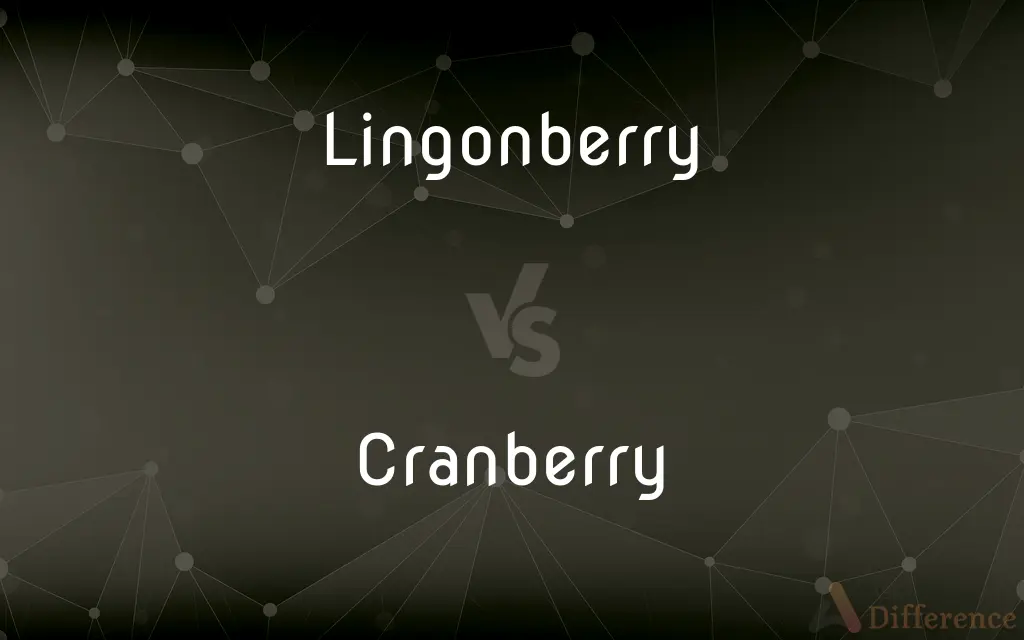Lingonberry vs. Cranberry — What's the Difference?
By Tayyaba Rehman — Updated on October 11, 2023
Lingonberries are small, red, and tart berries native to Northern Europe. Cranberries are larger, dark red, and native to North America. Both are used in jams, sauces, and baked goods.

Difference Between Lingonberry and Cranberry
Table of Contents
ADVERTISEMENT
Key Differences
Lingonberries, often found in the forests of Northern Europe, are small red berries that have a tart taste. Cranberries, on the other hand, are dark red fruits that are native to North America, particularly the northeastern and northcentral parts.
Lingonberries have been a staple in Scandinavian cuisine for centuries. They're often used in dishes like meatballs and are a key ingredient in various jams and preserves. Cranberries, in contrast, hold a special place in American culture, especially during Thanksgiving when they're commonly served as cranberry sauce.
The growing conditions for these berries are quite distinct. Lingonberries thrive in the boreal forests and Arctic tundra regions, benefiting from the cold climate. Cranberries, however, grow in acidic bogs, and their cultivation often involves a technique called "wet harvesting," where the bogs are flooded to make harvesting easier.
When it comes to health benefits, both berries are packed with nutrients. Lingonberries are rich in antioxidants, dietary fiber, and vitamin E. Cranberries are also antioxidant-rich and are especially known for their potential benefits in preventing urinary tract infections.
In the culinary world, both lingonberries and cranberries can be found in various forms, from fresh and dried to juices and jams. However, the distinct tartness of each berry means they bring their own unique flavor profile to dishes.
ADVERTISEMENT
Comparison Chart
Origin
Northern Europe
North America
Typical Habitat
Boreal forests & Arctic tundra
Acidic bogs
Size
Smaller
Larger
Taste
Tart
Dark red, tart
Popular Usage
Jams, sauces, Scandinavian dishes
Jams, sauces, Thanksgiving dishes
Compare with Definitions
Lingonberry
A berry that thrives in the cold climates of boreal forests and Arctic tundra.
During our hike in Sweden, we spotted wild lingonberry shrubs.
Cranberry
Known for its potential health benefits, especially in urinary tract infection prevention.
Drinking cranberry juice can help keep UTIs at bay.
Lingonberry
A small, red, tart berry native to Northern Europe.
I love adding fresh lingonberries to my morning oatmeal.
Cranberry
A traditional ingredient in American Thanksgiving dishes.
No Thanksgiving dinner is complete without cranberry sauce.
Lingonberry
A key ingredient in traditional Scandinavian jams and sauces.
My grandmother makes a delicious lingonberry jam every summer.
Cranberry
Grows in acidic bogs, often harvested using the "wet harvesting" technique.
The flooded fields full of floating cranberries are a sight to behold.
Lingonberry
A low creeping evergreen shrub (Vaccinium vitis-idaea), native to northern North America and Eurasia and having drooping clusters of small white or pinkish flowers.
Cranberry
Found in various culinary forms, from dried to juices.
I sprinkled some dried cranberries on my salad for a tart kick.
Lingonberry
The edible red berry of this plant, used to make sauces, jams, and preserves. In both senses also called cowberry, mountain cranberry.
Cranberry
Cranberries are a group of evergreen dwarf shrubs or trailing vines in the subgenus Oxycoccus of the genus Vaccinium. In Britain, cranberry may refer to the native species Vaccinium oxycoccos, while in North America, cranberry may refer to Vaccinium macrocarpon.
Lingonberry
A berry-bearing shrub, Vaccinium vitis-idaea, native to the cool temperate areas of the Northern Hemisphere.
Cranberry
A mat-forming, evergreen shrub (Vaccinium macrocarpon) in the heath family, native to eastern North America and widely cultivated for its tart, red, edible berries.
Lingonberry
The berry of this shrub.
Cranberry
The berries of this plant, used in sauces, jellies, relishes, and beverages.
Lingonberry
Low evergreen shrub of high north temperate regions of Europe and Asia and America bearing red edible berries
Cranberry
Any of several other plants in the genus Vaccinium having red berries, especially V. oxycoccos.
Lingonberry
Tart red berries similar to American cranberries but smaller
Cranberry
(countable) A shrub belonging to the section Vaccinium sect. Oxycoccus of the genus Vaccinium.
Lingonberry
A rich source of antioxidants, dietary fiber, and vitamin E.
Consuming lingonberries can be beneficial for your health.
Cranberry
(countable) The edible red berry of that shrub.
Lingonberry
A staple in Scandinavian cuisine, often paired with meat dishes.
Have you tried the Swedish meatballs with lingonberry sauce?
Cranberry
An intense red colour, like that of a cranberry
Cranberry
Of the intense red colour of a cranberry.
Cranberry
A red, acid berry, much used for making sauce, etc.; also, the plant producing it (several species of Vaccinum or Oxycoccus.) The high cranberry or cranberry tree is a species of Viburnum (Viburnum Opulus), and the other is sometimes called low cranberry or marsh cranberry to distinguish it.
Cranberry
Any of numerous shrubs of genus Vaccinium bearing cranberries
Cranberry
Very tart red berry used for sauce or juice
Cranberry
A dark red, tart fruit native to North America.
Cranberry juice is my go-to drink in the mornings.
Common Curiosities
Why are Cranberries associated with Thanksgiving?
Cranberries have become a traditional element of American Thanksgiving, typically served as cranberry sauce.
How are Lingonberries commonly used in cuisine?
Lingonberries are often used in Scandinavian dishes, particularly in jams, sauces, and paired with meats.
Can you eat Lingonberries raw?
Yes, you can eat Lingonberries raw, though they have a tart flavor that some might find too sharp.
Where do Cranberries come from?
Cranberries are native to North America, especially the northeastern and northcentral parts.
What health benefits do Lingonberries offer?
Lingonberries are rich in antioxidants, dietary fiber, and vitamin E, contributing to overall health.
Are there any famous dishes made with Cranberries other than the sauce?
Yes, Cranberries are also used in baked goods, salads, drinks, and dried as snacks.
What is a Lingonberry?
A Lingonberry is a small, red, tart berry native to Northern Europe.
Where do Lingonberries grow?
Lingonberries thrive in the boreal forests and Arctic tundra regions of Northern Europe.
Is Lingonberry jam similar to Cranberry sauce?
While both are made from tart red berries, Lingonberry jam is more associated with Scandinavian cuisine, while Cranberry sauce is an American Thanksgiving staple.
Can you substitute Cranberries for Lingonberries in recipes?
While both are tart, they have distinct flavors. Substitutions can be made, but it will alter the taste of the dish.
How do Lingonberries taste compared to Cranberries?
Both berries are tart, but Lingonberries have a sharper, more intense tartness compared to Cranberries.
Are Cranberries good for your health?
Absolutely! Cranberries are rich in antioxidants and are known to help prevent urinary tract infections.
How are Cranberries harvested?
Cranberries are often harvested using a technique called "wet harvesting," where bogs are flooded to make collection easier.
What's the biggest difference between Lingonberry and Cranberry?
The biggest difference lies in their origin and traditional culinary use, with Lingonberries being central to Scandinavian cuisine and Cranberries to North American dishes.
Are Cranberry juices natural diuretics?
Yes, Cranberry juice has diuretic properties, which can help flush out excess water and salts from the body.
Share Your Discovery

Previous Comparison
Macaw vs. Parrot
Next Comparison
Sensible vs. SensicalAuthor Spotlight
Written by
Tayyaba RehmanTayyaba Rehman is a distinguished writer, currently serving as a primary contributor to askdifference.com. As a researcher in semantics and etymology, Tayyaba's passion for the complexity of languages and their distinctions has found a perfect home on the platform. Tayyaba delves into the intricacies of language, distinguishing between commonly confused words and phrases, thereby providing clarity for readers worldwide.
















































